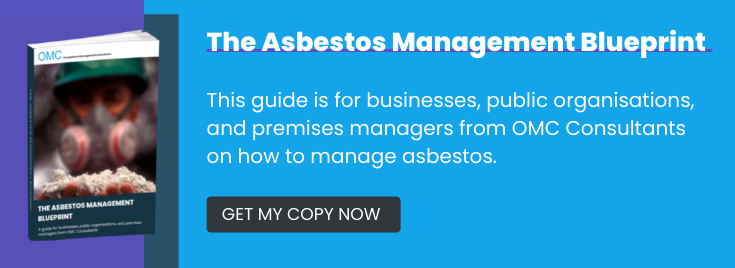Ensuring someone has responsibility for managing the risk of asbestos in a building is essential to protect employees and service users, and prevents negligence caused by a lack of accountability. Protecting employees and visitors from danger is a general duty under the Health and Safety at Work Act 1974 but, where the presence of asbestos poses a heightened risk, additional safeguards must be put in place.
Under the Control of Asbestos Regulations (CAR) 2012, whoever has responsibility for a building that contains asbestos has a legal duty to manage the risk – whether this is the landlord, owner-occupier, or leaseholder. It’s worth remembering that asbestos containing material (ACM) poses no increased risk if left untouched; instead, it is when asbestos is disturbed – such as through drilling or cutting into it, or attempting to remove it – that the risk occurs. Fibres of asbestos can be inhaled, causing life-limiting illnesses that may not emerge for many years.
The Control of Asbestos Regulations: Implications For Premises Owners (Duty Holders)
The Control of Asbestos Regulations established a control limit of asbestos exposure equivalent to 0.1 fibres per cubic centimetre of air during a four hour period, or 0.6 fibres per cubic centimetre over a 10 minute period. This applies to all types of asbestos but, for duty holders, this is clearly a difficult assessment to make without professional support. That’s why working with an expert in asbestos management can support duty holders to establish the level of risk posed by the ACM in their building.
Regulation 4 of the CAR requires duty holders to comply with several important steps:
- Ensure an appropriate risk assessment is carried out to check for asbestos.
- Assess the condition of materials likely to contain asbestos, such as ceilings.
- Inspect the building to find out if asbestos is present.
- Assess the risks posed by asbestos if it exists in the building.
- Write a plan that identifies where asbestos exists and the risks it poses (the Asbestos Management Plan). Health and Safety Executive guidance HSE 227 (Managing Asbestos) is particularly helpful here.
- Identify steps to manage any risks to personnel or visitors to the building.
- Ensure the safe and legal removal of asbestos where necessary.
- Ensure that all contractors and the emergency services are informed of the location and condition of asbestos should they be at risk of disturbing it.
Where work is being carried out and asbestos is discovered, ensure that activity ceases immediately to enable a professional survey by a qualified and competent surveyor/ organisation, working to a quality management system to ensure the highest standards.
Which Premises Are Affected By CAR?
Regulation 4 of the Control of Asbestos Regulations refers specifically to the need to manage asbestos risks in all non-domestic properties, such as schools, hospitals, offices, shops, warehouses, and factories.
While privately-owned domestic residences are not covered by the regulations, communal areas of flats and properties owned by housing associations or Local Authorities are included.
For Expert Asbestos Management, Contact OMC Consultants
At Occupational Management Consultants, we have over 50 years of combined experience in asbestos surveying, testing, and management. We provide expert support for premises owners to ensure they fulfil their legal obligations to assess, manage, and mitigate the risks posed by asbestos, so for more information, please get in touch on 01484 425043, or send us a message for a prompt response.

Image Source: Unsplash
